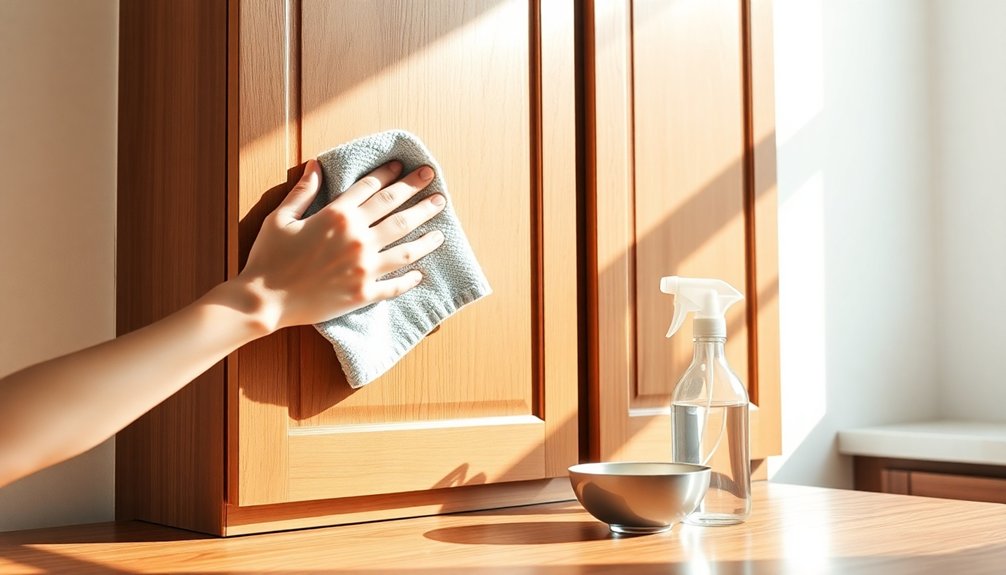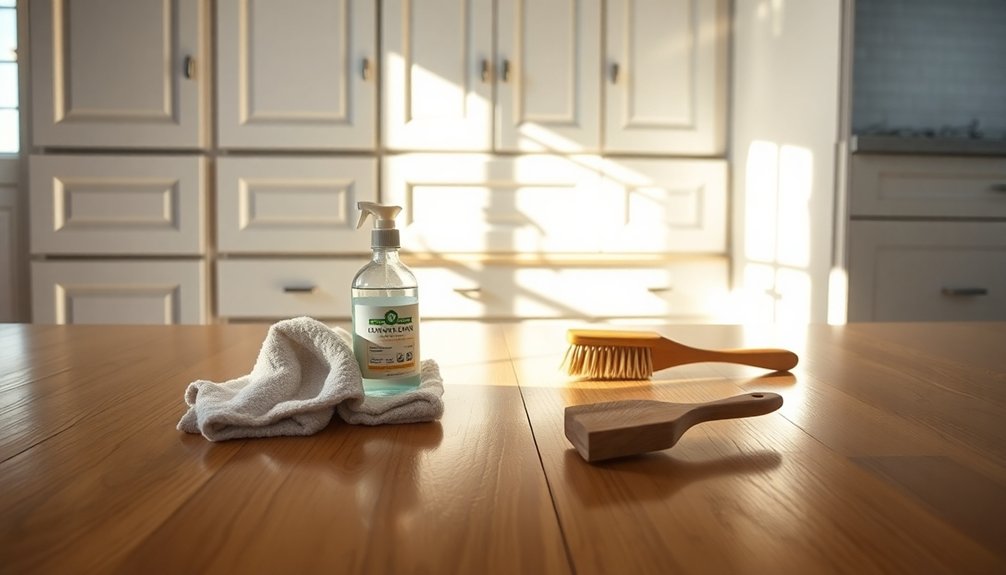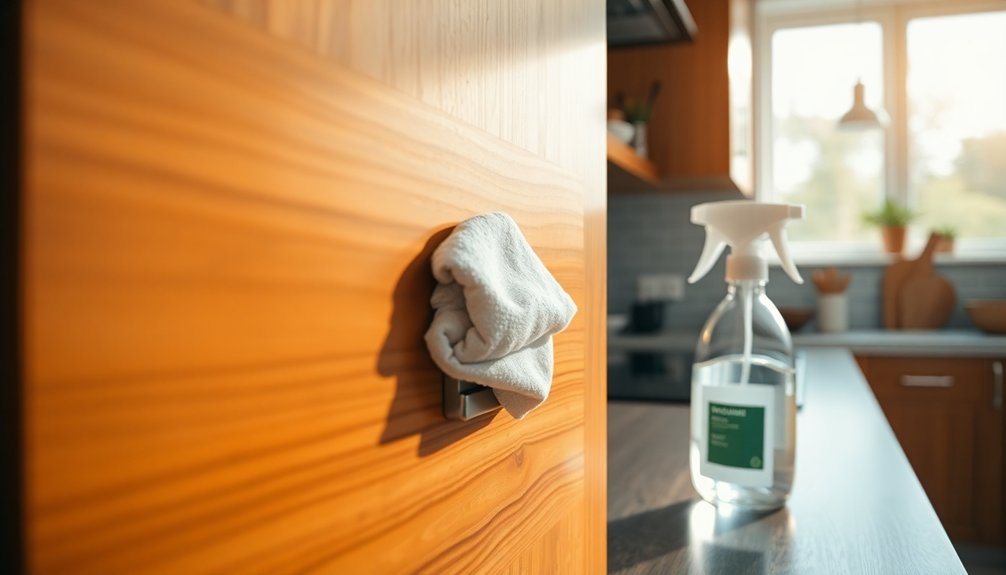To clean kitchen cabinets without damage, start by identifying their material. Use mild dish soap and warm water for wooden cabinets, avoiding acidic cleaners. Apply a damp cloth for cleaning, and always rinse surfaces to remove any residue; then, dry thoroughly to prevent moisture damage. For tougher stains, consider a baking soda paste. Regular maintenance keeps your cabinets looking great. Want to know more tips and techniques for specific materials? Keep exploring!
Understanding Cabinet Materials
When you clean your kitchen cabinets, it’s important to understand the different materials they’re made from, as each one requires unique care.
For greasy kitchen cabinets made of wood, using a cleaning solution with mild dish soap is ideal. This protects the finish while effectively removing grime.
For wooden kitchen cabinets, a mild dish soap solution effectively removes grease while preserving the finish.
Laminate cabinets need a gentle touch; all-purpose cleaners or diluted vinegar work well, but steer clear of abrasive materials that could scratch the surface.
For painted cabinets, opt for gentle cleaning solutions to avoid damaging the paint finish.
Engineered wood cabinets should be treated similarly to laminate, focusing on moisture control and gentle cleaning to prevent warping.
Understanding these materials helps guarantee your cabinets stay beautiful and functional. Regular maintenance prevents buildup and odors in your kitchen, ensuring a pleasant cooking environment.
Recommended Cleaning Solutions for Wood Cabinets
For maintaining the beauty of your wood cabinets, a pH neutral cleaner is your best bet. You can easily create a gentle cleaning solution by mixing mild dish soap with warm water. This combination effectively removes grease and grime without damaging the wood finish.
Murphy Oil Soap is another excellent option, as it cuts through dirt while leaving a silky finish and a pleasant citrus scent. Just remember to avoid acidic cleaners like vinegar or lemon juice, which can harm your cabinets over time. Additionally, regular cleaning helps extend the lifespan of your cabinets by preventing damage from neglect.
After cleaning, make sure to rinse surfaces with a damp cloth to eliminate any residue from the cleaning agents. Regular use of these solutions will help keep your cabinets looking great and extend their lifespan.
Proper Techniques for Cleaning Wood Cabinets

When cleaning wood cabinets, it’s essential to use the right solutions and techniques to protect their finish. Stick with a pH neutral cleaner, like mild dish soap and warm water, and always use a damp cloth to avoid excess moisture. Rinse and dry the surfaces promptly to maintain the wood’s integrity and prevent damage. Additionally, implementing regular decluttering can help maintain an organized kitchen space and make cleaning more efficient.
Recommended Cleaning Solutions
While maintaining the beauty of your wood cabinets, it’s crucial to choose the right cleaning solutions. A pH neutral cleaner, like mild dish soap mixed with warm water, effectively cleans without causing damage to your cabinets.
Avoid using acidic or alkaline cleaners, such as vinegar and baking soda, as they can harm the wood’s surface over time.
- Always rinse with a damp cloth to remove any residue.
- For tough stains, create a paste with one part baking soda and two parts water, letting it sit briefly before gently wiping it away.
- Make sure cabinets are dried thoroughly to prevent moisture damage.
With the right approach, your cabinets will stay beautiful and in great condition for years to come.
Effective Cleaning Techniques
To keep your wood cabinets looking their best, it’s important to use effective cleaning techniques that protect their finish.
Start by mixing mild dish soap with warm water for a pH neutral cleaner, perfect for tackling greasy cabinets. Use a damp cloth or sponge, applying a bit of elbow grease to scrub gently, especially on intricate designs.
Always rinse surfaces with a damp cloth afterward to remove any cleaning agents, preventing buildup that can harm your wood kitchen cabinets. Avoid soaking or using excessive water, as this can lead to warping or mold.
Regularly spot-clean spills and aim for a deep clean at least twice a year. These cleaning tips will help maintain the beauty and integrity of your cabinets.
The Importance of Rinsing and Drying
Rinsing and drying your kitchen cabinets properly is essential for maintaining their appearance and longevity. Proper rinsing surfaces with a damp cloth removes any residual cleaning agent, preventing dirt buildup.
After rinsing, drying wood cabinets thoroughly is vital; excessive moisture can lead to mold and deformation.
- Always rinse from top to bottom to avoid drips.
- Use a soft cloth for gentle drying; avoid hot air, which can damage wood fibers.
- Consistent moisture removal helps enhance their appearance and prolong lifespan. Regular cleaning routines also promote a hygienic sink environment that can benefit adjacent surfaces in your kitchen.
Common Mistakes to Avoid When Cleaning Cabinets

Maintaining your kitchen cabinets goes beyond rinsing and drying; it’s also about avoiding common pitfalls that can lead to damage.
First, avoid using acidic cleaners like vinegar or lemon juice, as they can harm wood finishes.
Avoid acidic cleaners like vinegar or lemon juice, as they can damage wood finishes.
Don’t soak your cabinets or use excessive water, since moisture can seep into joints and cause warping.
Steer clear of abrasive cleaning tools that scratch surfaces and strip away protective finishes.
Also, refrain from unproven home remedies like baking soda or olive oil, which can leave unwanted residue.
When cleaning greasy kitchen spots, give extra attention to rinsing surfaces with a damp cloth to eliminate any cleaning solution residue, preventing buildup and keeping your cabinets looking fresh. Additionally, opt for non-toxic cleaners that are gentle on surfaces while still being effective against grease and grime.
How to Clean Laminate Cabinets Effectively
To clean your laminate cabinets effectively, start with a mixture of mild dish soap and warm water.
Use a lint-free cloth to apply the solution and rinse with a clean, damp cloth to avoid residue buildup.
Regular dusting will also help keep your cabinets looking their best with minimal effort. Additionally, regular cleaning of laminate surfaces prevents dirt and grime accumulation.
Recommended Cleaning Solutions
Cleaning laminate cabinets effectively requires a gentle approach to preserve their finish while tackling grime.
Start by mixing mild dish soap with warm water to clean kitchen surfaces without causing damage. Use a soft cloth to wipe away dirt, avoiding abrasive cleaners and scrub pads that could scratch the finish. For tough stains, apply a baking soda paste, let it sit briefly, then gently wipe away.
- Regularly dust cabinet doors with a lint-free cloth to prevent buildup.
- Rinse the cabinets with a clean, damp cloth to eliminate soap residue.
- Dry them immediately to prevent moisture damage.
Maintenance Tips and Tricks
While laminate cabinets can add a sleek touch to your kitchen, keeping them in top shape requires consistent care.
Start by regularly dusting your cabinets with a dry microfiber cloth to prevent dirt buildup. For deeper cleaning, mix mild dish soap with warm water, and avoid abrasive products that could scratch the finish.
Use a clean cloth dampened with warm water to rinse, minimizing moisture exposure to avoid warping. Always dry surfaces immediately with a soft cloth to prevent streaks and moisture damage.
For tough grease stains, create a paste using one part baking soda and two parts water, gently rubbing the area before rinsing and drying.
These maintenance tips will keep your laminate cabinets looking their best.
Tips for Maintaining the Appearance of Cabinets

Maintaining the appearance of your kitchen cabinets is essential for keeping your space looking fresh and inviting. To achieve this, follow these practical tips:
- Regularly wipe cabinet surfaces with a damp microfiber cloth using a pH neutral cleaner, like mild dish soap, to prevent grease and dirt buildup.
- Avoid acidic or alkaline cleaners that can damage finishes, and always dry cabinets thoroughly with a dry cloth after cleaning to prevent moisture damage.
- Conduct seasonal deep cleans by emptying cabinets and focusing on corners to maintain their overall appearance.
For an added touch, use a citrus-based oil on laminate cabinets or mild oil soap on wood cabinets to shine your cabinets without leaving harmful residues. Additionally, be sure to implement daily cleaning routines to keep surfaces free of dirt and grime.
With these gentle cleaning methods, your cabinets will always look their best!
When to Consider Professional Help for Cabinet Cleaning
If you’ve noticed that your kitchen cabinets are accumulating significant grease, wax, or smoke that regular cleaning just can’t tackle, it might be time to contemplate professional help.
Consider professional help if your kitchen cabinets are struggling with stubborn grease, wax, or smoke buildup.
A professional cleaning service can provide a thorough restoration that DIY methods often can’t achieve. If you see wear or damage on your cabinet finish, professional help can prevent further deterioration.
For extensive cabinet repairs needing specialized tools and expertise, hiring a pro guarantees quality results. If you lack the time or knowledge to deep clean effectively, professionals can tailor their services to your specific cabinet materials.
They often use advanced techniques like wood reconditioning and colorant application, elevating the clean wood look beyond what you can do at home. Additionally, they may employ eco-friendly methods to ensure your cabinets are cleaned without exposure to harsh chemicals.
Conclusion
In conclusion, keeping your kitchen cabinets clean doesn’t have to be intimidating. By understanding the materials and using the right techniques, you can restore their shine without damage. Think of it like polishing a gem; a little care goes a long way. Remember to rinse and dry thoroughly, avoid common pitfalls, and maintain them regularly. If the job feels overwhelming, don’t hesitate to call in the pros. Your cabinets deserve the best care!